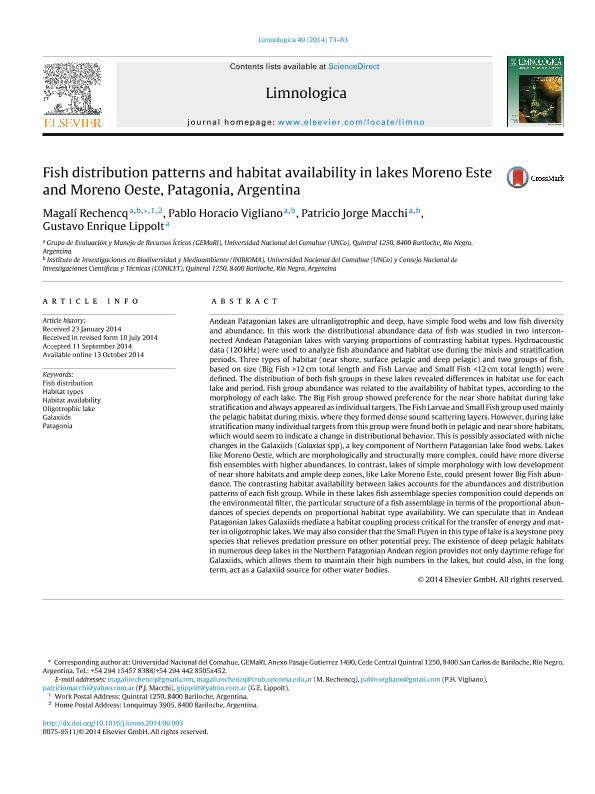Artículo
Fish distribution patterns and habitat availability in lakes Moreno Este and Moreno Oeste, Patagonia, Argentina
Fecha de publicación:
11/2014
Editorial:
Elsevier Gmbh
Revista:
Limnologica
ISSN:
0075-9511
Idioma:
Inglés
Tipo de recurso:
Artículo publicado
Clasificación temática:
Resumen
Andean Patagonian lakes are ultraoligotrophic and deep, have simple food webs and low fish diversity and abundance. In this work the distributional abundance data of fish was studied in two interconnected Andean Patagonian lakes with varying proportions of contrasting habitat types. Hydroacoustic data (120 kHz) were used to analyze fish abundance and habitat use during the mixis and stratification periods. Three types of habitat (near shore, surface pelagic and deep pelagic) and two groups of fish, based on size (Big Fish >12 cm total length and Fish Larvae and Small Fish <12 cm total length) were defined. The distribution of both fish groups in these lakes revealed differences in habitat use for each lake and period. Fish group abundance was related to the availability of habitat types, according to the morphology of each lake. The Big Fish group showed preference for the near shore habitat during lake stratification and always appeared as individual targets. The Fish Larvae and Small Fish group used mainly the pelagic habitat during mixis, where they formed dense sound scattering layers. However, during lake stratification many individual targets from this group were found both in pelagic and near shore habitats, which would seem to indicate a change in distributional behavior. This is possibly associated with niche changes in the Galaxiids (Galaxias spp), a key component of Northern Patagonian lake food webs. Lakes like Moreno Oeste, which are morphologically and structurally more complex, could have more diverse fish ensembles with higher abundances. In contrast, lakes of simple morphology with low development of near shore habitats and ample deep zones, like Lake Moreno Este, could present lower Big Fish abundance. The contrasting habitat availability between lakes accounts for the abundances and distribution patterns of each fish group. While in these lakes fish assemblage species composition could depends on the environmental filter, the particular structure of a fish assemblage in terms of the proportional abundances of species depends on proportional habitat type availability. We can speculate that in Andean Patagonian lakes Galaxiids mediate a habitat coupling process critical for the transfer of energy and matter in oligotrophic lakes. We may also consider that the Small Puyen in this type of lake is a keystone prey species that relieves predation pressure on other potential prey. The existence of deep pelagic habitats in numerous deep lakes in the Northern Patagonian Andean region provides not only daytime refuge for Galaxiids, which allows them to maintain their high numbers in the lakes, but could also, in the long term, act as a Galaxiid source for other water bodies.
Palabras clave:
Fish Distribution
,
Habitat Tipe
,
Holigotrophic Lake
,
Galaxiids
,
Patagonia
Archivos asociados
Licencia
Identificadores
Colecciones
Articulos(INIBIOMA)
Articulos de INST. DE INVEST.EN BIODIVERSIDAD Y MEDIOAMBIENTE
Articulos de INST. DE INVEST.EN BIODIVERSIDAD Y MEDIOAMBIENTE
Citación
Rechencq, Magali; Vigliano, Pablo Horacio; Macchi, Patricio Jorge; Lippolt, Gustavo Enrique; Fish distribution patterns and habitat availability in lakes Moreno Este and Moreno Oeste, Patagonia, Argentina; Elsevier Gmbh; Limnologica; 49; 11-2014; 73–83
Compartir
Altmétricas




